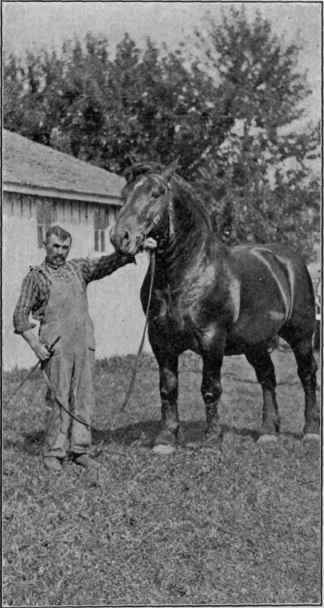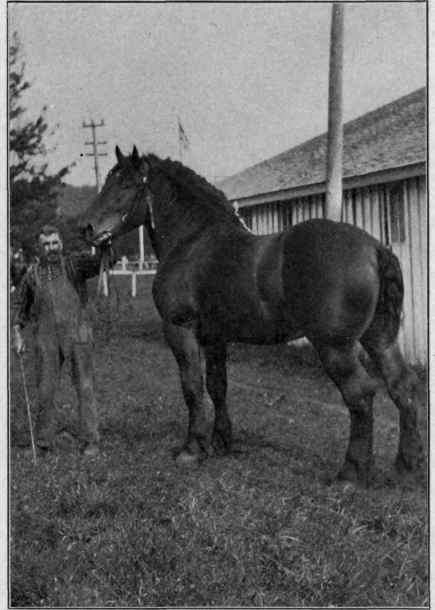Belgian Draft - Horse
Description
This section is from the book "The Horse", by Isaac Phillips Roberts. Also available from Amazon: The horse.
Belgian Draft - Horse
The Belgian horse has not been so popular in the United States as the Clyde and the Percheron. The reason why these two breeds have been imported and bred in far greater numbers than the other draft-breeds is believed to be due to the fact that both of these breeds possess not only good draft form, but superior action, courage and style, for horses produced as they were, largely from the phlegmatic branch of the genus Equus Caballus. Be this as it may, the American requires that even his draft-horse shall not pound the pavement too heavily, or be as slow and as unresponsive as an ox.
It may be, that, to gratify this taste of the American for a lively stepper and a "bit champer," the breeders, in some cases, have produced a draft -horse with too long a neck and too slanting a shoulder. A distinguished importer and breeder once said to me: "The 'toppy' horses sell, but the short-necks, while less stylish, wear best."
It is probable that the Belgian has little or no admixture of "hot blood." He certainly has quite as many of the true draft points as have the two breeds so largely admired. The illustrations of the best horses of the breed show a larger horse than the Clyde; the neck is shorter, the breast wider, and the whole body-formation more blocky than is usually seen in the Clydesdales, and he has less feather than the Clyde.

Fig. 43. Brilliant Du Basquest. Owned by Henry Lefebure, Fairfax, Iowa.

Fig. 44. Colonel De Dompiere. Owned by Henry Lefebure, Fairfax, Iowa.
It is a good thing for the horse industry that there are not only breeds of widely divergent characteristics, but also breeds so slightly different as to deceive the experts unless the breed name is placarded. All this serves to educate the eye and the judgment, as well as to form interesting topics for discussion.
Horses imported since 1888 must be registered in the Government Register of Belgium (Society of Bel-gia Stock Farmers), to be eligible for registration in the American Register.
Description
Color usually bay, dark and light browns - all good colors. They are somewhat larger than the Percherons. Selected mature stallions, such as are usually imported, weigh from 1,700 to 2,200 pounds, and mature mares from 1,500 to 1,900 pounds. The head is reasonably small; neck short and very powerful; chest wide and deep; back short and broad; close-ribbed, and full over kidneys; hips fairly long, broad, smooth and symmetrical; legs short, flat, arm heavy-muscled, with the usual open, rather low heel of the draft breeds. This breed has not been as popular as the Percherons and the Clydes. Probably this is due to its build, which indicates a breed of less activity than the two great leading draft breeds adopted by the Americans. As seen in his native country he does not strike one as having the long, elastic, quick stride of the Scotch or French draft-horse.
Continue to:


